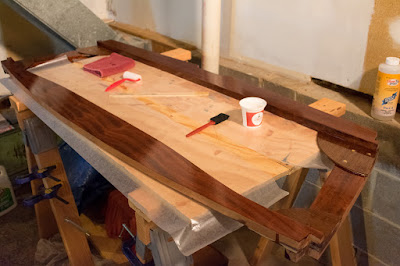I took the advice of some other, and frankly more talented, boatbuilders. After sanding the surface (again) and vacuuming the epoxy dust away (again), I wiped the surface off thoroughly (again), but this time with denatured alcohol.
WHY denatured alcohol? To tell you the truth, I'm not sure. My best guess is that it evaporates more quickly than water. All I know is, I used it based on qualified advice, and it worked.
 |
| Floor beam sanded (again) and wiped with denatured alcohol |
 |
| I also sanded one of the gussets (again). Looks like I went through the epoxy. |
 |
| And, I sanded this gusset. Again. |
So, after sanding and cleaning, I applied a thin coat of epoxy (again) using a thin foam roller and cheap foam brush as before.
 |
| This is what the offending surface looked like before. |
 |
| Same area, after sanding, cleaning, and a fourth coat. |
 |
| You can even see my coffee mug reflected in the surface. |
















